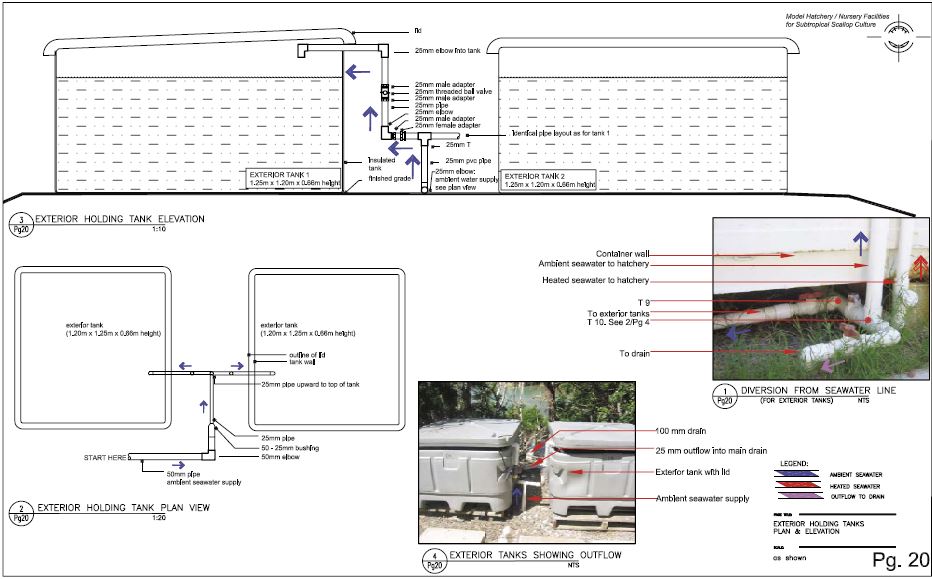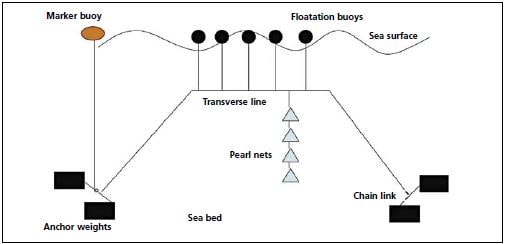Chapter 5 Growout of juveniles: transfer from nursery to field
5.1 HOLDING AND Growout FACILITIES
Facilities for holding scallop spat prior to transfer to the field for growout are described below. These exterior facilities can also be used for maintaining adult scallops, or for other purposes. These facilities are found extremely useful when bringing back young juveniles from the field for further sorting on land, if weather conditions do not allow sorting on the boat.
The main requirements are cleanliness, as for the rest of the complex, and high water flow. Animals held in these tanks are usually not fed, and for this reason, cannot be kept for extended periods of time. Longline system used in Bermuda is described thereafter; this system is efficient for suspending pearl nets, scallop trays and/or collector bags.
5.1.1 Exterior holding tanks
Refer to Technical Drawing – ?? page ??20. Two square insulated ?“B??ONAR??” tanks ??? (400 litres volume) are installed outside the hatchery on a wooden base. They are supplied with seawater through an open system, with coarsely filtered seawater diverted from the main line, prior to entry into the hatchery complex. Technical drawing diagram – 1/Pg20
illustrates the main valve regulating the flow to the exterior tanks from the pump house. The relative position of the heated seawater line and ambient seawater line supplying the hatchery can also be seen. Finally, any excess flow, pumped in but not used, is diverted to a main drain pipe, buried sub-surface and not seen in this photo. This photo is also represented in detail in technical drawing diagram? ?? ??? – 2/P ??
Technical drawing, Pg. 20
Exterior holding tanks: Plan & elevation

Plumbing for these tanks is very simple and done using a 50 mm pipe buried in the ground, running to the tanks. As seen in technical drawing diagram – 2/Pg20, a 50 mm elbow is fitted to the supply line, and points upwards to direct the flow of water to the tanks. From there, the pipe is reduced to 25 mm using a 50 mm to 25 mm bushing, and runs in the centre of the two tanks. A T-junction then divides the line into two. The tank elevation diagram (see technical drawing – 3/Pg20) shows the detailed connections for supply. As these tanks are cleaned, emptied and re-filled frequently, a flexible system, allowing complete drainage of the vertical pipe system, is required. The centre T-junction is fitted with a 25 mm female and male adapter threaded into one another, then glued to a clear elbow. This allows for the entire “arm” to swivel, and allows for draining of the supply pipe. The clear elbow allows to monitor any clogging of the coarsely filtered seawater supply. A 25 mm male adapter threads into a 25 mm threaded ball valve and regulates the flow of seawater into each tank. Once again this allows for turning of the pipe system to divert flow away from tank, required when cleaning. Finally a series of two 25 mm elbow direct the flow into the tank, and flow is supplied via a 25 mm inner diameter re-enforced tubing fitted to the pipe, running to the bottom of the tank.
Outflow is through a standpipe at the opposite end of the tank connected to a bottom drain. The drain is sealed with an O-ring and caulking, fitted with a thru-hull fitting, and connected to a 25 mm pipe draining into the main 100 mm drain pipe. This can be seen in technical drawing photo – 4/Pg20.
Despite high exposure to direct sunlight in Bermuda, the insulating capacity of these tanks, and high water flow generated, maintained an adequate environment for scallops throughout the year.
5.1.2 LONGLINES
Calico scallops have shown good shell growth and survival rate, as well as complete reproductive development when reared in suspended cultures. This method is used widely for various scallop species (Bourne, Hodgson and Whyte, 1989; Couturier, Dabinett and Lanteigne, 1989). Animals are reared in nets suspended from longlines in the water column. Longlines consist of two anchor lines and one transverse line with floats. There are various designs in use where transverse lines are maintained at the surface or submerged at various depths. The system in Bermuda consists mainly of a sub-surface transverse line, maintained at approximately 1.5 m depth with 30 cm diameter black floats (Figure 5.1). Each float has a floatation of 14.5 kg; they are spaced every meter and tied securely to the transverse line. The rope used is a floating type

Figure 5.1: Sub-surface longline system used in Bermuda.
rather than sinking type. Maintenance of the line sub-surface serves two purposes: the first is related to the observed better performance of scallops reared below the surface, due most probably to the lack of inhibition from the UV rays. The second reason is related to minimized wave action due to wind, optimizing the longevity of the nets and of the whole system.
Anchor lines are, as a rule, twice as long as the depth of the water, so that in 10 m of water, each anchor line is 20 m long. They are attached to anchors made of any heavy material retrieved locally; in this case, plastic coated lead weights used for ballasts on boats were used, amounting to 68 kg per anchor. A 2 m chain length is connected to the anchors with shackles to facilitate replacing of the longline when needed. The anchor lines themselves are spliced into loops, protected by plastic tubing. Shackles connect the anchor lines to the chain and the plastic tubing avoids chafing of the rope.
In Bermuda, it is found, that a line needs replacing after two years. Square pearl nets are tied together to form a column of nets, with the last net being one metre off the bottom. As scallops grow, densities are reduced within the nets and nets of increasing mesh size are utilized; such that pearl nets of 3, 6 and 12 mm mesh size are used from juvenile to adult/market stage. Thus, in Bermuda, a 90 m longline set in 8 m of water, can support approximately 20 000–25 000 adult scallops. In the initial set-up, it is recommended to order more than the 12 mm nets needed, as some will tear due to bad weather or to predators.
Prior to transfer of spat to the field, longlines have to be prepared and set in selected sites. When selecting a site for scallop growout, the following considerations should be taken into account. Protection from storms, good water quality, high flow of water, water depth, protection from vandalism and other users, distance from nursery or ease of access.
5.1.3 BOTTOM CAGES
As mentioned in Chapter 4, growout of zigzag scallops to 25 mm juveniles is similar to that described for calico scallops. Unfortunately, this species does not fare well in suspended cultures for the rest of its life cycle, and exhibits optimal growth rates when cultured directly on the sandy bottom. Its natural behaviour, recessing in the sand, seems to play a role in limiting fouling on the shell, and enhancing growth. Growout cages used in Bermuda are shown in Figure 5.2. These cages protect scallops from predators as there is mesh on top and sides, but allow scallops to recess on the sandy bottom. Descriptions of the cages experimented with in Bermuda are not given in detail, as this system is not cost efficient. It is extremely labour intensive due to the continuous monitoring of the cages by SCUBA. Survival rate is very dependent on density, and loading density per cage is low (10 scallops per m2). In order to make growout of zigzag scallops commercially feasible another growout method needs to be devised.

Figure 5.2: Schematic diagram of bottom cages made of rebar and plastic mesh used for protection of sand scallop (Euvola ziczac) juveniles and adults. Fouling on meshed lid shown close up, necessitating retrieval of cages from field.